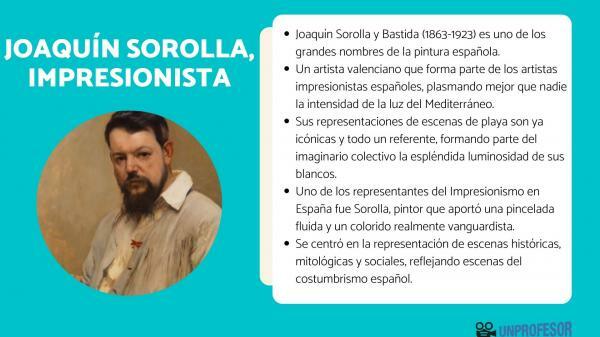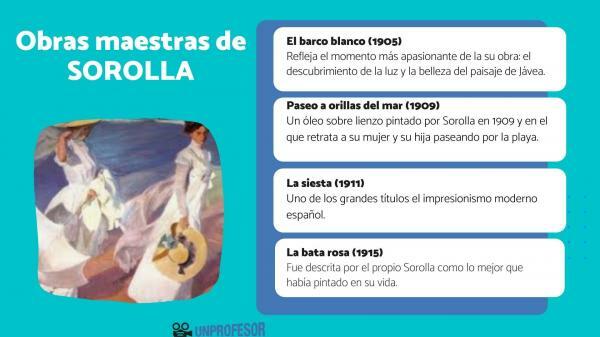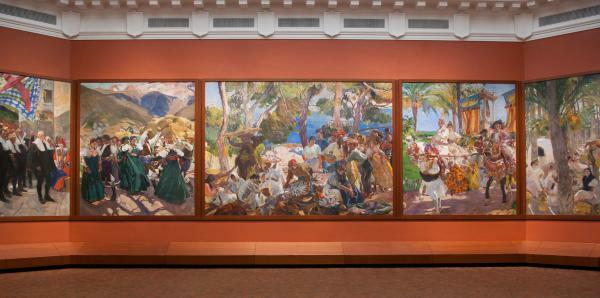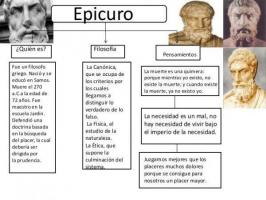Life and work of SOROLLA, IMPRESSIONIST painter

Joaquín Sorolla y Bastida (1863-1923) is one of the great names in Spanish painting. A Valencian artist who is one of the Spanish impressionist artists, capturing the intensity of the Mediterranean light better than anyone. His representations of beach scenes are already iconic and a reference, the splendid luminosity of his targets forming part of the collective imagination.
In this lesson unPROFESOR.com we stop at the figure of Sorolla impressionist painter so that you can know what are the main characteristics of his style and his work.
Index
- What kind of painting is Sorolla's?
- 1900. Sorolla's learning years
- 1910. Maturity period
- 1920. Sorolla's final phase
What kind of painting is Sorolla's?
Joaquin Sorolla he dominated both the representations of water and beach scenes as well as the portrait and painting of all kinds of landscapes, capturing the intensity of the light and the blue glow of the coasts. His work developed between
1860 and 1920, a time of changes both economically and socially, ideologically, politically or artistically.Thus, in this environment arises the Impressionism as a new pictorial movement in front of which figures such as Monet, Manet, Of gas or Renoir, among others. Some authors who created a style of the most groundbreaking and innovative and whose objective was the capture of light and painting in the open air.
One of the representatives of this new pictorial movement was Sorolla, a painter who contributed a fluid brushstroke and a truly avant-garde color. In addition, Sorolla focused on the representation of historical, mythological and social scenes, reflecting scenes of Spanish manners.

1890-1900. Sorolla's learning years.
Sorolla returns to Spain in 1889 after training in Rome for four years with an art scholarship. In those years he studied classical subjects, mainly historical and religious. At that time he was influenced by painters like the Danish. Krøyer and the Swede Anders Zorn. Painters who used bright colors and intense light, two influences that will be basic in Sorolla's style.
In Rome, Sorolla also developed a taste for paint outdoors, although most of his work focused on portraits of society and social realism-themed paintings. In some of these works, Sorolla was inclined to recreate claustrophobic environments and atmospheres that are reminiscent of Velázquez, a teacher with great influence on the painter.
One of the Sorolla's masterpieces, "Another Margarita!" (1892), a painting that represents a woman detained and handcuffed for the murder of her son. Another equally harsh painting is Slave Trade (1895), in which Sorolla represents an old woman with four of her prostitutes.

1900-1910. Maturity period.
In this years Sorolla achieves international fame, being the moment in which he performs his more important works, the beach scenes. Some scenes that he painted every summer that he went to Valencia. His work as a photographer in his youth greatly influenced his style giving a photographic touch to his subject matter and his brushwork.
In addition to drawing inspiration from outdoor themes, Sorolla also uses an elevated point of view, disappearing the horizon or opening a space between the painting and the viewer. Some techniques inherited from photography and that manage to introduce the viewer as a participant and observer.
Another feature is the vibrant colors and pastel colors like blues, pinks, and whites, with a lot of light. The works capture a specific moment offering a feeling of peace, calm and carefree.
This style of Sorolla follows the example of the french impressionists, portraying the characters in a natural way and expressing a great interest in portraiture in the most authentic way. Like Monet, Sorolla works “plain air” to reproduce the effect of sunlight on objects.
Thus, Sorolla strives to capture the change of light throughout the hours of the day and the seasons of the year. The figures appear in the paintings of him always bathed in the rays of the sun. During these years, Sorolla presented his first exhibition in Paris in 1906 in Paris, as well as in Berlin, Dusselford, Cologne, London and the United States.
His most popular works are A walk by the sea (1909), The horse's bath (1909) and The bathhouse (1909).
1910-1920. Sorolla's final phase.
In this final decade, Sorolla continues to paint these types of scenes with an impressionist style, although this last decade of his pictorial career Sorolla received a large commission from the Hispanic Society of America. An assignment that consisted of carrying out Visions of Spain and in which he had to paint typical scenes of the Spanish regions and with traditional regional costumes.
In this commission Sorolla painted 14 huge canvases which are exhibited at the Museum of New York. At the end of 1911, Sorolla got down to work to carry out this great work. In it popular scenes set in most of the Spanish regions were represented.
The commission was completed in 1919 and went from a single 60-meter-long mural to 14 large canvases.

If you want to read more articles similar to Sorolla, impressionist painter, we recommend that you enter our category of History.
Bibliography
- TORRES GONZÁLEZ, Begoña (2009). Sorolla: The magic of light. Madrid, Editorial LIBSA.
- SOROLLA, J; DÍEZ GARCÍA, J; BARÓN, J (2009). Prado Museum, ed. Joaquín Sorolla, 1863-1923. Madrid
- TOMÁS FERRÉ, Facundo (2006). Joaquín Sorolla: (1863-1923). Hobbies, 7. Madrid: TF Editores



